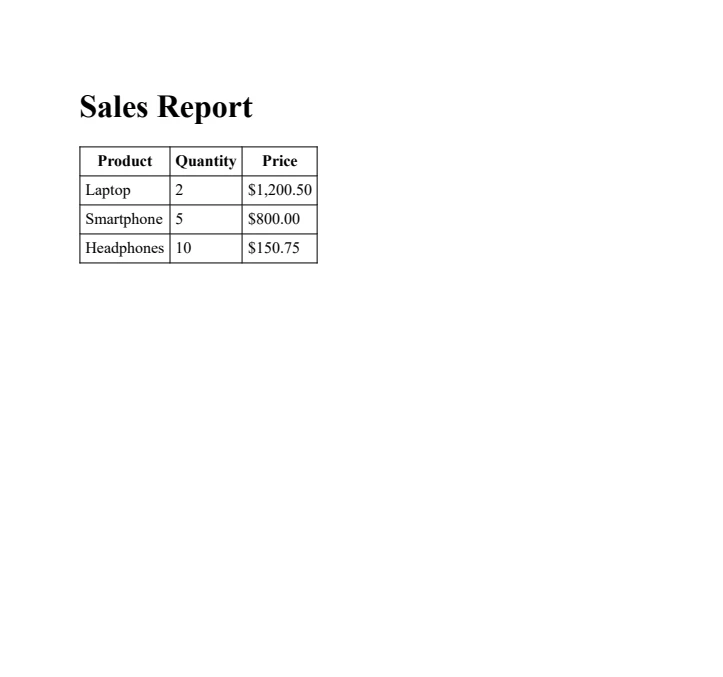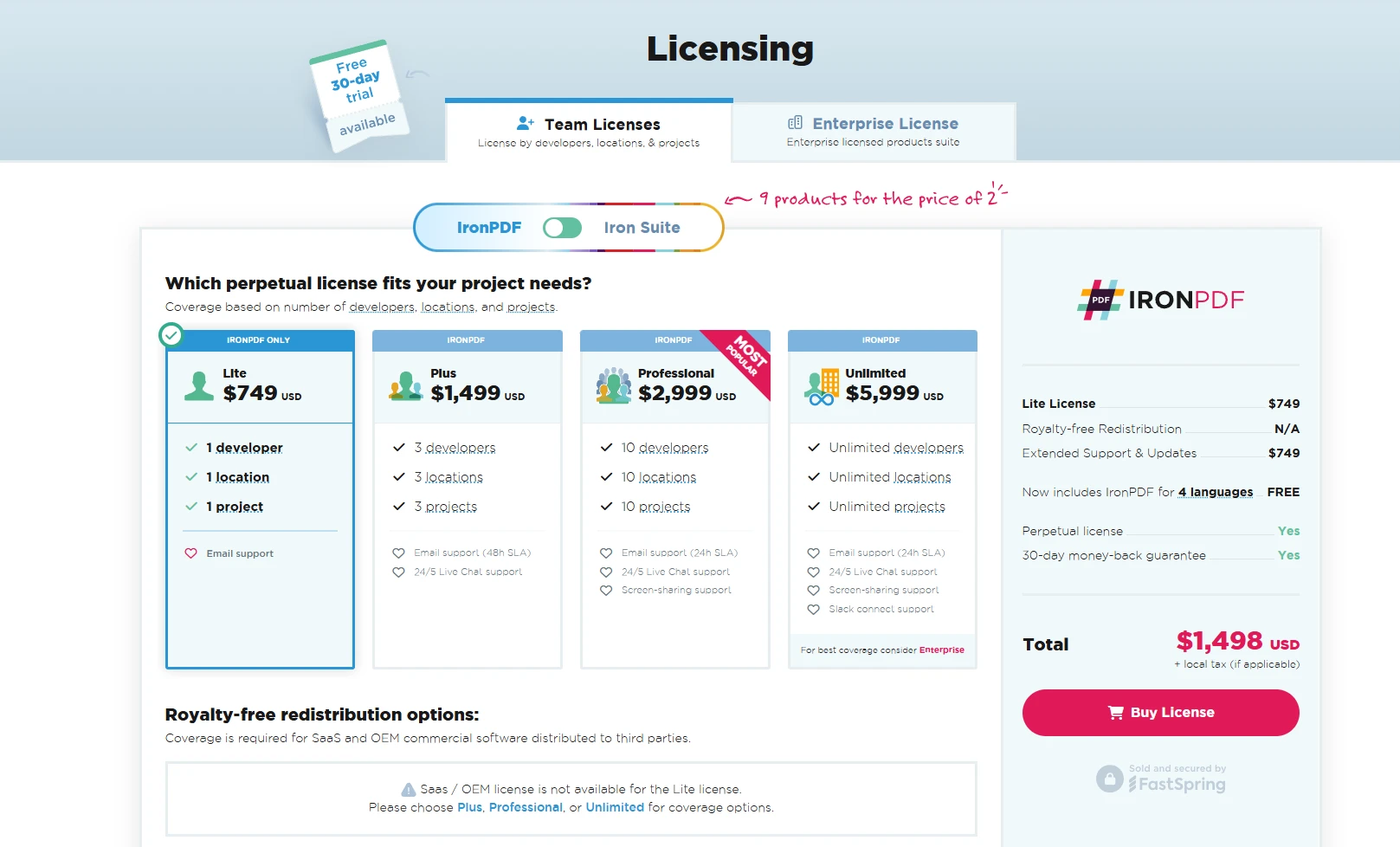Test in production without watermarks.
Works wherever you need it to.
Get 30 days of fully functional product.
Have it up and running in minutes.
Full access to our support engineering team during your product trial
Anonymous types in C# provide a mechanism to encapsulate public read-only properties into a single anonymous type object without explicitly defining a formal class declaration. It is useful for the single object structure. They are compiler-generated types that derive directly from System.Object, encapsulating object properties efficiently and serving as lightweight, immutable data containers. These types are sealed classes where the compiler automatically infers and generates the type name, which remains inaccessible at the source code level. We'll also discover IronPDF as the PDF library for the dot NET projects.
Anonymous data-type objects excel in LINQ query expressions, particularly in select clauses for anonymous-type objects, where they efficiently return specific property subsets from larger objects. This approach optimizes memory usage by creating temporary objects containing only the necessary data.
They serve as efficient containers for temporary data structures when creating a formal class would be excessive. This is particularly useful for short-lived data transformations or intermediate calculations.
Anonymous data type provides a clean way to bundle related object properties together using read-only properties. The compiler ensures type safety while maintaining a concise syntax for property access.
The creation of anonymous types follows a specific pattern using the var keyword along with the new operator and object initializer syntax. The compiler automatically generates a type name that remains inaccessible at the source code level.
var person = new { FirstName = "Iron", LastName = "Dev", Age = 35 }; // public int age in this anonymous typevar person = new { FirstName = "Iron", LastName = "Dev", Age = 35 }; // public int age in this anonymous typePrivate person = New With {
Key .FirstName = "Iron",
Key .LastName = "Dev",
Key .Age = 35
}The compiler enforces strict rules for property initialization in anonymous types. All properties must be initialized during object creation and cannot be assigned null values or pointer types. Once initialized, property values of an anonymous type's property can be accessed using standard dot notation, but they cannot be modified after initialization due to their read-only nature.
var person1 = new { Name = "Iron", Age = 30 };
var person2 = new { Name = "Dev", Age = 25 };var person1 = new { Name = "Iron", Age = 30 };
var person2 = new { Name = "Dev", Age = 25 };Dim person1 = New With {
Key .Name = "Iron",
Key .Age = 30
}
Dim person2 = New With {
Key .Name = "Dev",
Key .Age = 25
}The compiler generates identical type information for anonymous types with matching property names, types, and order. This allows type compatibility between instances to be used in collections or passed as method parameters within the same assembly.
Anonymous data type supports complex nested structures with anonymous-type object properties. It is helpful for the creation of hierarchical data representations:
var student = new {
Id = 1,
PersonalInfo = new {
Name = "James",
Contact = new {
Email = "james@email.com",
Phone = "123-456-7890"
}
},
Grades = new { Math = 95, Science = 88 }
};var student = new {
Id = 1,
PersonalInfo = new {
Name = "James",
Contact = new {
Email = "james@email.com",
Phone = "123-456-7890"
}
},
Grades = new { Math = 95, Science = 88 }
};Dim student = New With {
Key .Id = 1,
Key .PersonalInfo = New With {
Key .Name = "James",
Key .Contact = New With {
Key .Email = "james@email.com",
Key .Phone = "123-456-7890"
}
},
Key .Grades = New With {
Key .Math = 95,
Key .Science = 88
}
}Anonymous types excel in scenarios involving collection manipulation and data transformation:
var items = new[] {
new { ProductId = 1, Name = "Laptop", Price = 1200.00m },
new { ProductId = 2, Name = "Mouse", Price = 25.99m },
new { ProductId = 3, Name = "Keyboard", Price = 45.50m }
};var items = new[] {
new { ProductId = 1, Name = "Laptop", Price = 1200.00m },
new { ProductId = 2, Name = "Mouse", Price = 25.99m },
new { ProductId = 3, Name = "Keyboard", Price = 45.50m }
};Dim items = {
New With {
Key .ProductId = 1,
Key .Name = "Laptop",
Key .Price = 1200.00D
},
New With {
Key .ProductId = 2,
Key .Name = "Mouse",
Key .Price = 25.99D
},
New With {
Key .ProductId = 3,
Key .Name = "Keyboard",
Key .Price = 45.50D
}
}IronPDF is a powerful library for generating, editing, and managing PDF documents in .NET applications. When working with C#, developers often use anonymous objects for lightweight and ad hoc data structures, especially for scenarios where creating an entire class isn't necessary. These anonymous objects can be seamlessly utilized with IronPDF to create PDF documents dynamically. It helps in creating a flexible solution for quick data-to-PDF workflows. Here’s an example to illustrate how IronPDF works with anonymous objects:
Imagine you have a list of sales data you want to render as a table in a PDF. Instead of creating a formal class, you can use an anonymous object to quickly format the data for rendering.
using IronPdf;
using System;
using System.Linq;
class Program
{
static void Main()
{
License.LicenseKey = "Licenes-Key";
// Sample data using anonymous objects
var salesData = new[]
{
new { Product = "Laptop", Quantity = 2, Price = 1200.50 },
new { Product = "Smartphone", Quantity = 5, Price = 800.00 },
new { Product = "Headphones", Quantity = 10, Price = 150.75 }
};
// Create an HTML string dynamically using the anonymous object data
var htmlContent = @"
<html>
<head><style>table {border-collapse: collapse;} th, td {border: 1px solid black; padding: 5px;}</style></head>
<body>
<h1>Sales Report</h1>
<table>
<thead>
<tr>
<th>Product</th>
<th>Quantity</th>
<th>Price</th>
</tr>
</thead>
<tbody>
" +
string.Join("", salesData.Select(item =>
$"<tr><td>{item.Product}</td><td>{item.Quantity}</td><td>{item.Price:C}</td></tr>")) +
@"
</tbody>
</table>
</body>
</html>";
// Generate the PDF
var renderer = new ChromePdfRenderer();
var pdf = renderer.RenderHtmlAsPdf(htmlContent);
// Save the PDF
pdf.SaveAs("SalesReport.pdf");
Console.WriteLine("PDF generated successfully!");
}
}using IronPdf;
using System;
using System.Linq;
class Program
{
static void Main()
{
License.LicenseKey = "Licenes-Key";
// Sample data using anonymous objects
var salesData = new[]
{
new { Product = "Laptop", Quantity = 2, Price = 1200.50 },
new { Product = "Smartphone", Quantity = 5, Price = 800.00 },
new { Product = "Headphones", Quantity = 10, Price = 150.75 }
};
// Create an HTML string dynamically using the anonymous object data
var htmlContent = @"
<html>
<head><style>table {border-collapse: collapse;} th, td {border: 1px solid black; padding: 5px;}</style></head>
<body>
<h1>Sales Report</h1>
<table>
<thead>
<tr>
<th>Product</th>
<th>Quantity</th>
<th>Price</th>
</tr>
</thead>
<tbody>
" +
string.Join("", salesData.Select(item =>
$"<tr><td>{item.Product}</td><td>{item.Quantity}</td><td>{item.Price:C}</td></tr>")) +
@"
</tbody>
</table>
</body>
</html>";
// Generate the PDF
var renderer = new ChromePdfRenderer();
var pdf = renderer.RenderHtmlAsPdf(htmlContent);
// Save the PDF
pdf.SaveAs("SalesReport.pdf");
Console.WriteLine("PDF generated successfully!");
}
}Imports IronPdf
Imports System
Imports System.Linq
Friend Class Program
Shared Sub Main()
License.LicenseKey = "Licenes-Key"
' Sample data using anonymous objects
Dim salesData = {
New With {
Key .Product = "Laptop",
Key .Quantity = 2,
Key .Price = 1200.50
},
New With {
Key .Product = "Smartphone",
Key .Quantity = 5,
Key .Price = 800.00
},
New With {
Key .Product = "Headphones",
Key .Quantity = 10,
Key .Price = 150.75
}
}
' Create an HTML string dynamically using the anonymous object data
Dim htmlContent = "
<html>
<head><style>table {border-collapse: collapse;} th, td {border: 1px solid black; padding: 5px;}</style></head>
<body>
<h1>Sales Report</h1>
<table>
<thead>
<tr>
<th>Product</th>
<th>Quantity</th>
<th>Price</th>
</tr>
</thead>
<tbody>
" & String.Join("", salesData.Select(Function(item) $"<tr><td>{item.Product}</td><td>{item.Quantity}</td><td>{item.Price:C}</td></tr>")) & "
</tbody>
</table>
</body>
</html>"
' Generate the PDF
Dim renderer = New ChromePdfRenderer()
Dim pdf = renderer.RenderHtmlAsPdf(htmlContent)
' Save the PDF
pdf.SaveAs("SalesReport.pdf")
Console.WriteLine("PDF generated successfully!")
End Sub
End Class

Anonymous types in C# provide a flexible and efficient way to create temporary data structures without the need for formal class declarations. They are particularly useful when working with LINQ queries, data transformations, and libraries like IronPDF. Combining anonymous types with IronPDF's PDF generation capabilities offers a powerful solution for creating dynamic, data-driven PDFs with minimal code overhead.
IronPDF allows developers to test its features through a free trial, making it easy to explore its capabilities in your .NET applications. Commercial licenses start at $749 and grant access to its full feature set, including high-performance HTML-to-PDF rendering, PDF editing, and security features.